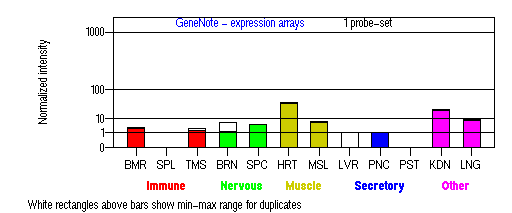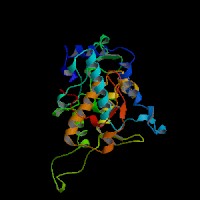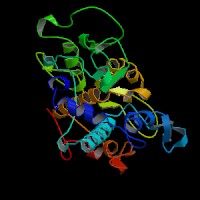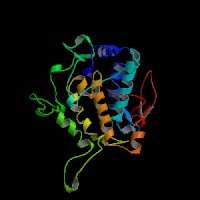GENOMIC
Mapping
9q23. View the map and FISH BAC clones (data from UCSC genome browser).

Structure
(assembly 07/03)
TYRP1/NM_000550: 8 exons, 16,810bp, Chr9: 12,683,449 - 12,700,258.
The figure below shows the structure of the TRRP1 gene (data from UCSC genome browser).

Regulatory Element
Search the 5'UTR and 1kb upstream regions (human and mouse) by CONREAL with 80% Position Weight Matrices (PWMs) threshold (view results here).
The flanking DNA of TRP-1, unlike tyrosinase, does not contain a TATA box or a CCAAT box. Both mouse genes, however, share an 11bp sequence, also found in human tyrosinase, which may be a melanocyte-specific promoter element (Jackson, et al).
TRANSCRIPT
RefSeq/ORF
TYRP1 (NM_000550), 2,797bp, view ORF and the alignment to genomic.
Expression Pattern
Tissue specificity: Pigment cells.

BMR: Bone marrow; SPL: Spleen; TMS: Thymus; BRN: Brain; SPC: Spinal cord; HRT: Heart; MSL: Skeletal muscle;
LVR; Liver; PNC: Pancreas; PST: Prostate; KDN: Kidney; LNG: Lung. (data from GeneCards )
PROTEIN
Sequence
Tyrosinase-related protein 1 (NP_000541): 537aa, ExPaSy NiceProt view of Swiss-Prot:P17643.
Synonyms: 5,6-dihydroxyindole-2-carboxylic acid oxidase [Precursor] (DHICA oxidase); TRP-1; TRP1; TRP; Catalase B; Glycoprotein-75 (gp75); Melanoma antigen gp75.
Ortholog
| Species | Mouse | Cow | Rat |
| GeneView | b/Tyrp1 | TYRP1 | Tyrp1 |
| Protein | NP_112479 (537aa) | NP_776905 (537aa) | XP_238398 (537aa) |
| Identities | 85% /458aa | 88% /476aa | 84% /456aa |
| Species | Chicken | Zebrafish | Worm |
| GeneView | LOC395913 | 18995 | C34G6.2 |
| Protein | NP_990376 (535aa) | 17347 (275aa) | 08574(751aa) |
| Identities | 75% /408aa | 43% /121aa | 25% /62aa |
View multiple sequence alignment (PDF files) by ClustalW and GeneDoc.
Domain
(1) Domains predicted by SMART:
a) signal peptide 1-25
b) Pfam: Tyrosinase 121-471
c) tansmembrane 479-501
(2) Transmembrane domains predicted by SOSUI: two transmembrane helices detected.
| No. | N terminal | transmembrane region | C terminal | type | length |
| 1 | 3 | SYNVLPLAYISLFLMLFYQVWAQ | 25 | SECONDARY | 23 |
| 2 | 477 | EIITIAVVAALLLVAAIFGVASC | 499 | PRIMARY | 23 |
(3) Graphical view of InterPro domain structure.
Motif/Site
(1) Predicted results by ScanProsite:
a) EGF-like domain signature 1 :
99 - 110: ChCngnfsGhnC
b) Laminin-type EGF-like (LE) domain signature :
99 - 122: Ch.CngnfsGhnCgtCrpg.Wrgaa...........C
c) Tyrosinase CuA-binding region signature :
215 - 232: Hegpa.FLtWHRyhLlrlE
d) Tyrosinase and hemocyanins CuB-binding region signature :
397 - 408: DPiFVllHtftD
e) N-myristoylation site : [occurs frequently]
52 - 57: GTdrCG,
57 - 62: GSssGR,
103 - 108: GNfsGH,
267 - 272: GSrsNF,
300 - 305: GTlcNS.
f) Protein kinase C phosphorylation site : [occurs frequently]
53 - 55: TdR,
60 - 62: SgR,
112 - 114: TcR,
163 - 165: TrR,
195 - 197: SvK,
253 - 255: TgK,
354 - 356: SfR,
366 - 368: TgK.
g) N-glycosylation site : [occurs frequently]
96 - 99: NRTC,
104 - 107: NFSG,
181 - 184: NISI,
304 - 307: NSTE,
350 - 353: NSTN,
385 - 388: NGTG,
533 - 536: NQSV.
h) cAMP- and cGMP-dependent protein kinase phosphorylation site : [occurs frequently]
152 - 155: KRtT
i) Tyrosine sulfation site : [occurs frequently]
289 - 303:
vcdsledYdtlgtlc,
519 - 533:
yqcyaeeYeklqnpn
(2) Predicted results of subprograms by PSORT II:
a) Seems to have a cleavable signal peptide (1 to 24)
b) KDEL ER retention motif in the C-terminus: none
c) ER Membrane Retention Signals: none
d) VAC possible vacuolar targeting motif: none
e) Actinin-type actin-binding motif: type 1: none; type 2: none
f) Prenylation motif: none
g) memYQRL transport motif from cell surface to Golgi: none
h) Tyrosines in the tail: found at 498, 518, 521, 525
i) Dileucine motif in the tail: found LL at 514
3D Model
(1) ModBase entry found, results here.
(2)ModBase Predicted Comparative 3D Structure of P17643 from UCSC Genome Sorter.



From left to right: Front, Top, and Side views of predicted protein
2D-PAGE
This protein does not exist in the current release of SWISS-2DPAGE.
Computed theoretical MW=60,724Da, pI=5.62 (NP_000541).
FUNCTION
Ontology
a) Biological process: melanin biosynthesis from tyrosine
b) Monooxygenase activity; oxidoreductase activity
c) Integral to membrane
d) Belongs to the tyrosinase family
Location
Type I membrane protein. Melanosome.
Interaction
Tyrosinase-related protein 1 (TYRP1) is involved in maintaining stability of tyrosinase protein and modulating its catalytic activity. TYRP1 binds 2 copper ions per subunit via CuA and CuB motifs. Phosphorylation of tyrosinase by PKC-beta induces a complex formation between tyrosinase and TYRP1 (Wu, et al).
Pathway
TYRP1 is a melanocyte-specific gene product involved in eumelanin synthesis. It functions in the oxidation of 5,6-dihydroxyindole-2-carboxylic acid (DHICA) into indole-5,6-quinone-2-carboxylic acid (Olivares, et al). TYRP1 may play a significant role in mediating ethnic differences in melanogenesis and constitutive skin pigmentation in vivo (Alaluf, et al). TYRP1 plays a role in the distal pigment eumelanin pathway. TYRP1 is sorted to the melanosomes for melanin synthesis with an AP-3 complex independent pathway (Huizing, et al) (view diagram of melanosome maturation in melanocytes here).
KEGG Biochemical Pathways:
hsa00350 - Tyrosine metabolism - Homo sapiens
MUTATION
Allele or SNP
3 mutations deposited in HGMD.
SNPs deposited in dbSNP.
2 selected allelic examples described in OMIM.
Distribution
The distribution of 2 mutations and 7 polymorphisms is described in detail in Albinism Database. For cross-reference, view the distribution of mutations in the Retina International Mutation Database of TYRP1 Gene.
Except the 3 mutations (p.S166X, p.R373X, c.368delA) in HGMD, two novel mutations (R356E, L36delT) have been reported in a German family (Rooryck, et al (2006)). In addition, Rooryck, et al (2008)) reported two novel mutations on TYRP1 (c.780_791del and c.1057_1060del) in a Chinese patient.
Effect
In the OCA3 patient with the 1104delA mutation, both TYRP1 transcripts and the tyrosinase-related protein-1 (TRP-1) was not detected in the melanocytes (Boissy, et al).
PHENOTYPE
Defects in TYRP1 (OMIM 115501) are the cause of oculocutaneous albinism type III (OCA3) (Boissy, et al) (OMIM 203290). OCA3 is a rare form of OCA and patients are born with minimal pigmentation but increase their pigmentation as they age. Individuals with OCA3 are recognized by their reddish skin and hair color. The loss of TYRP1 activity does not lead to a loss, but a change in the amount of eumalanin. Mutations in TYRP1 result in a less severe type of albinism as compared with null mutations of the TYR gene in OCA1.
Defects in TYRP1 are the cause of rufous oculocutaneous albinism (ROCA) (Manga, et al) (OMIM 278400). ROCA occurs in blacks and is characterized by bright copper-red coloration of the skin and hair and dilution of the color of the iris. A German patient of Caucasian origin shows a light-yellow skin, yellow-gold hair with orange highlights, fair eyelashes, several pigmented naevi, and no tendency to tan, only to burn. Eye-colour is blue-green with substance defects of the iris (Rooryck, et al (2006)).
REFERENCE
- Alaluf S, Barrett K, Blount M, Carter N. Ethnic variation in tyrosinase and TYRP1 expression in photoexposed and photoprotected human skin. Pigment Cell Res 2003; 16: 35-42. PMID: 12519123
- Boissy RE, Zhao H, Oetting WS, Austin LM, Wildenberg SC, Boissy YL, Zhao Y, Sturm RA, Hearing VJ, King RA, Nordlund JJ. Mutation in and lack of expression of tyrosinase-related protein-1 (TRP-1) in melanocytes from an individual with brown oculocutaneous albinism: a new subtype of albinism classified as "OCA3". Am J Hum Genet 1996; 58: 1145-56. PMID: 8651291
- Huizing M, Sarangarajan R, Strovel E, Zhao Y, Gahl WA, Boissy RE. AP-3 mediates tyrosinase but not TRP-1 trafficking in human melanocytes. Mol Biol Cell 2001; 12: 2075-85. PMID: 11452004
- Jackson IJ, Chambers DM, Budd PS, Johnson R. The tyrosinase-related protein-1 gene has a structure and promoter sequence very different from tyrosinase. Nucleic Acids Res 1991; 19: 3799-804. PMID: 1907365
- Manga P, Kromberg JG, Box NF, Sturm RA, Jenkins T, Ramsay M. Rufous oculocutaneous albinism in southern African Blacks is caused by mutations in the TYRP1 gene. Am J Hum Genet 1997; 61: 1095-101. PMID: 9345097
- Olivares C, Jimenez-Cervantes C, Lozano JA, Solano F, Garcia-Borron JC. The 5,6-dihydroxyindole-2-carboxylic acid (DHICA) oxidase activity of human tyrosinase. Biochem J 2001; 354: 131-9. PMID: 11171088
- Rooryck C, Roudaut C, Robine E, Musebeck J, Arveiler B. Oculocutaneous albinism with TYRP1 gene mutations in a Caucasian patient. Pigment Cell Res 2006;19:239-42.PMID: 16704458
- Rooryck C, Morice-Picard F, Elcioglu NH, Lacombe D, Taieb A, Arveiler B. Molecular diagnosis of oculocutaneous albinism: new mutations in the OCA1-4 genes and practical aspects. Pigment Cell Melanoma Res. 2008; 21: 583-7. PMID: 18821858
- Wu H, Park HY. Protein kinase C-beta-mediated complex formation between tyrosinase and TRP-1. Biochem Biophys Res Commun 2003; 311: 948-53. PMID: 14623273
EDIT HISTORY:
Created by Wei Li & Jonathan Bourne: 07/28/2004
Updated by Wei Li: 08/08/2007
Updated by Wei Li: 02/23/2009
Updated by Wei Li: 03/15/2010